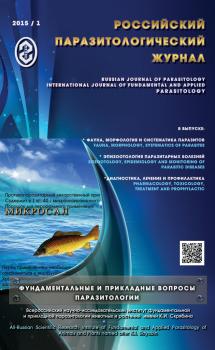Objective of research: to study the regional epizootology, species composition and bioecological features of development of causative agents of cattle hypodermatosis and elaboration of struggle measures against it in the Chechen Republic. Materials and methods: Data on extensity and intensity of invasion, species composition of causative agents of cattle hypodermatosis, seasonal dynamics, larval approach to the surface of animal back (gadfly larvae deposited in animals’ skin), time of the larval-pupal transformation (stages of larval development), treatment and prevention measures are provided in this article. Results and discussion: This research has found that in the Chechen Republic the extensity of gadfly invasion was in the range 24,4% — 62,1%; the intensity of invasion was 9,8 — 24,0 larv./animal. Two gadfly species Hypoderma bovis De Geer and Hypoderma lineatum De Villers are causative agents of animal hypodermatosis. H. bovis is spread everywhere, H. lineatum — mainly in plain and piedmont of the republic. Gadfly flight in different natural-climatic zones of the republic is registered from the end of April until the middle of October. Treatment and prevention measures continuously conducted for the whole livestock ( in spring against larvae of the 1st stage and in autumn — against larvae of the 2nd and 3rd development stages), taking into account ecological, phenological and epizootological situation in the region, may contribute to the full elimination of causative agents of hypodermatosis or their significant minimizing, reduction of economic damage to livestock of the republic. Based on experimental data, the economically reasonable schedule of treatment and prevention measures has been created.
hypodermatosis, epyzootology, extensity, intensity, bioecological features, daily activity, species composition, seasonal dynamics.
Введение
Гиподерматоз крупного рогатого скота — хроническое заболевание, вызываемое личинками подкожных оводов двух видов: обыкновенного подкожника или строки (Hypoderma bovisDeGeer) и южного подкожника пищеводника (HypodermalineatumDeVillers) [2,3]. Характеризуется воспалительными явлениями в местах локализации личинок и путей их миграции, общей интоксикацией организма, снижением молочной и мясной продуктивности животных и качества шкур.
Овода относятся к насекомым с полным превращением. В своём развитии они проходят фазы: яйца, личинки, куколки и имаго. Выход имаго оводов из куколок происходит очень быстро — в течение 2-3 сек. и через 30-60 сек. муха способна летать и размножаться. После спаривания самки сразу же отправляются на поиски животных для откладки яиц. Формирование личинок внутри яйца продолжается у строки 3-7, у пищеводника — 3-6 дней. Вылупившиеся из яиц личинки проникают в тело хозяина. В дальнейшем, личинки I стадии строки мигрируют вдоль крупных сосудов и нервов к позвоночнику и через межпозвоночные отверстия попадают в жировую ткань спинномозгового канала, а личинки I стадии пищеводника мигрируют в сторону пищевода и локализуются в его подслизистом слое. Личинки II и III стадий, из пищевода и спинномозгового канала мигрируют в область спины и поясницы, где формируют соединительнотканные капсулы. Для дальнейшего развития они нуждаются в кислороде атмосферного воздуха, для чего образуют в коже свищевые отверстия. После образования свища личинки линяют и переходят в III стадию. Созревшие личинки III стадии через свищевые отверстия в коже выходят из капсулы и падают на землю, где окукливаются. Развитие куколок при колебании температуры в пределах 10–21 °С и относительной влажности 60-80% продолжается 1-1,5 суток.
1. Vatsaev Sh.V. Gipodermatoz krupnogo rogatogo skota (epizootologiya, vidovoy sostav, populyatsionnaya ekologiya) i razrabotka mer bor’by s nim v Chechenskoy Respublike: dis. kand. vet. nauk [Hypodermatosis in cattle (epyzootology, species composition, population ecology) and elaboration of struggle measures against it in the Chechen Republic. Diss. PhD vet. sci.]. St. Petersburg, 2008. 128 p. (In Russian)
2. Grunin K.Ya. Opredelitel’ po faune SSSR (Zoologicheskiy institut AN SSSR) lichinki ovodov domashnih zhivotnyh SSSR [Guide for the identification of fauna of the USSR (Institute of Zoology of the USSR Academy of Sciences) botfly larvae in domestic animals of the USSR], M., 1968, i. 51. 204 p. (In Russian)
3. Grunin K.Ya. Fauna SSSR. Podkozhnye ovoda (Hypodermatidae) [Fauna of the USSR. Subcutaneous gadflies (Hypodermatidae)]. M., USSR Academy of Sciences, 1962, vol. Х1Х, i.4. 238 p. (In Russian)
4. Nepoklonov A.A., Hire T., Shlistezer H., Dorzh Z.. Bolezni zhivotnyh, vyzyvaemye ovodami [Animal diseases caused by gadflies]. M., 1980.
5. Tolokonnikov V.P., Lysenko I.O., Vatsaev Sh.V. et. al. Enthomoses in farm animals and elaboration of struggle measures against them . Trudy Kubanskogo gos. agrarnogo universiteta [Proc. of Kuban State Agrarian University], 208, i. 2, pp. 215-219. (In Russian)
6. Tolokonnikov V. P., Gipodermatoz krupnogo rogatogo skota i mery bor’by s nim: rekomendatsii dlya prakt. vet. vrachey [Hypodermatosis in cattle and struggle measures against it: Recommendations for practicing veterinarians]. Stavropol, Stavropol State Agrarian University, 2010. 20 p. (In Russian)





